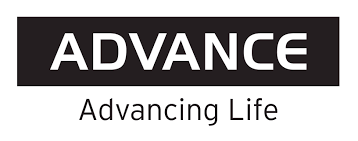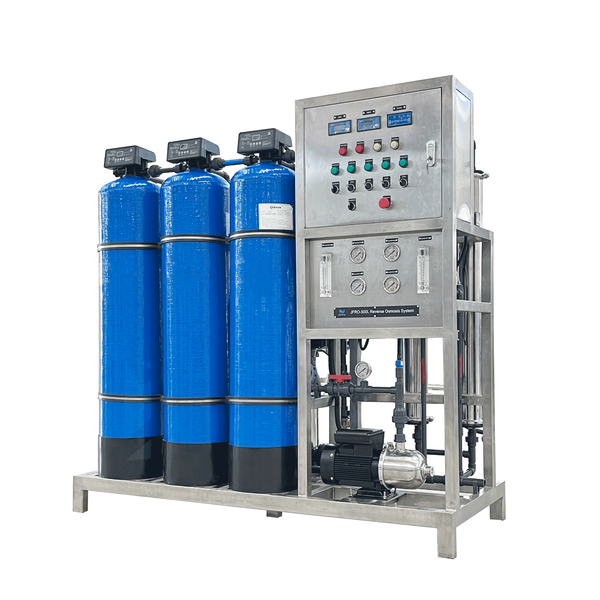The Advance water Commercial Reverse Osmosis Water Purification System uses an advanced membrane technology that effectively removes impurities, producing great taste water.
It’s easy to install and can fully automatic operate, consists of raw water pump, FRP pretreatment water tanks, precision filter, 4040 RO membrane, SUS/FRP membrane housing, high pressure pump and electric control box.
The chemical cleaning system, PLC, touch screen, and some parts brand can be adds or changes as customer demand.
Advance water’s commercial reverse osmosis systems are suitable for tap water, municipal water and other water sources with a TDS of 0-2000ppm.
Our team of engineers will select the most suitable size of pre-treatment FRP tank, the amount of filter materials, and the tank material based on the raw water analysis and the purpose of produced water. The pretreatment part usually consists of quartz sand, activated carbon filters and water softener, which is very important for a reverse osmosis system.


How does Commercial Reverse Osmosis work?
RO works using a high-pressure pump to apply pressure on the salt side of the RO system and to force the water across the semi- permeable RO membrane, leaving almost all (95% to 99%) of dissolved salts behind in the reject stream.
The amount of pressure required depends on the salt concentration of the feed water. The more concentrated the feed water, the more pressure is required to overcome the osmotic pressure.

Specification of 500LPH reverse osmosis system
| Model | JFRO-500L | ||
| Producing Capacity | 500L/H | RO membrane | 4” |
| Recovery Rate | ≥75% | Power Supply | Single-phase: 110/120/220V 50/60Hz |
| Operating Pressure | 0.5-1.0MPa | Tri-phase: 110/220/380/415V 50/60Hz | |
| Desalination Rate | 99% | Power Consumption | 2kW |
| Filtration Accuracy | 0.0001 micron | Control Type | Manual control / Auto control |
| Feed Water Quality | SDI<5 Free Chlorine Concentration<0.1mg/L TDS<2000mg/L | ||
| Features | Removes impurities such as inorganic ions, bacteria, viruses, organic matter and colloids from raw water. | ||
The details of 500LPH reverse osmosis system

What will Reverse Osmosis remove from water?
RO can remove 95-99% of dissolved salts (ions), particles, colloids, organics, bacteria, and pyrogens from feed water. An RO membrane rejects contaminants based on their size and charge. Any contaminant with a molecular weight greater than 200 will likely be rejected by a properly running RO system.
RO systems cannot remove dissolved gases, such as carbon dioxide (CO2), very well because they are not highly ionized (charged) while in solution and have a very low molecular weight. Because RO systems do not remove gases, permeate water can have a slightly lower than normal pH level, depending on dissolved CO2 in the feed water since CO2 is converted to carbonic acid.
RO is very effective in treating brackish, surface and ground water for both large and small flow applications.
What is the 4 Benefits of Commercial Reverse Osmosis System?
- Water Purity
Commercial reverse osmosis systems produce water that is relatively pure and free from: suspended solids, dissolved minerals, organic carbon, chemicals, viruses, bacteria, and parasites.
- Environmentally Friendly
Commercial reverse osmosis systems do not produce or employ the use of harsh chemicals during the purification process and require minimal power to operate.
- Cost Effective
Most commercial reverse osmosis systems employ only the most highly efficient pumps. With rapid developments in membrane technology over the past several decades, reverse osmosis has become one of the most cost-efficient technologies for deionizing water.
- Money Saving
Water purified through reverse osmosis will minimize mineral scaling, fouling and spotting, result in higher equipment operating efficiencies, reduce waste.
Standard Features:
Quartz sand filter, activated carbon filter and other pretreatment part
Compact stainless steel frame
Famous RO membrane barnd, such as DOW, Toray, LG, Vontron…
FRP membrane housings
Centrifugal pump
Pressure gauges
Flowmeter
Electric control panel
Design Considerations for Commercial Reverse Osmosis
For an commercial RO system to operate at maximum efficiency, several factors must be taken into consideration during the design process.
- Water Source:
The source of feedwater for commercial reverse osmosis has one of the greatest impacts on the overall design of the unit, including the number of required filtration stages for pretreatment. Water from a stable source, such as a groundwater supply, will typically require a simpler pretreatment process than water from a more complex source, such as surface water or wastewater.
- Pure Water Production Capacity (L/day, L/Hour, GPD).
- Temperature and Flow Rate:
The flux rate, or rate at which water passes through a membrane, varies markedly with water temperature.
- Pretreatment:
For example: Chlorine, while beneficial for disinfecting municipal water, will deteriorate reverse osmosis membranes. Dechlorination is achieved by activated carbon filtration, as part of the pretreatment process.
- Microbiological Contaminants:
Although not generally as damaging as scaling, microbiological contaminants trapped in the membrane of a reverse osmosis system can also result in fouling and a loss of production capacity.
- Silt Density Index:
Significant levels of very fine particles (i.e., silt) in water can result in frequent membrane cleanings, or even premature membrane failure.
What Industries Benefit from the Utilization of Commercial RO systems?
- Breweries and Distillers
- Food processing.
- Pharmaceutical manufacturing.
- Hospitals and Health care facilities.
- Hotel and Hospitality Industry.
- Aquariums and Zoos.
- Greenhouse and Agriculture.
- Automotive industry.
How to Maintain an Commercial Reverse Osmosis System
Maintaining an commercial reverse osmosis system involves replacing essential filters to prevent clogging.
Phase 1: Pre-Filter
During phase 1 of reverse osmosis, water passes through a pre-filter to protect fragile reverse osmosis membranes. Pre-filters filtrate sediments such as sand, dirt, silt and other particles. Individuals should change the pre-filter regularly to prevent it from clogging. If this filter becomes clogged, it can cause the pre-filter to collapse or cause particulates to enter the membranes.
Phase 2: RO Membrane
Phase two is the reverse osmosis phase. During this phase, strong pressure pushes water through the RO membrane. After the water passes through, the membrane holds contaminants on one side while pressure pushes the water back through the membrane to the previous side.
Contaminants travel down the drain after the membrane catches them. The filter and membrane’s lifespans will vary based on facility use and water quality, but the person responsible for maintaining the system should clean the RO membranes when needed and try to replace the RO membrane every two to three years.
Why Is RO System Maintenance Important?
RO system maintenance is important because it ensures a system works efficiently. Preventative maintenance can help to identify issues before they cause damage, and scheduled filter replacements can ensure systems remain unclogged and operate efficiently. Regular cleaning maintains water quality and prevents membrane damage, saving money on expensive replacements. RO system preventative maintenance is an economical way to maintain systems.



